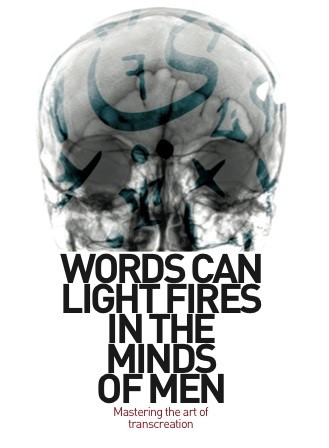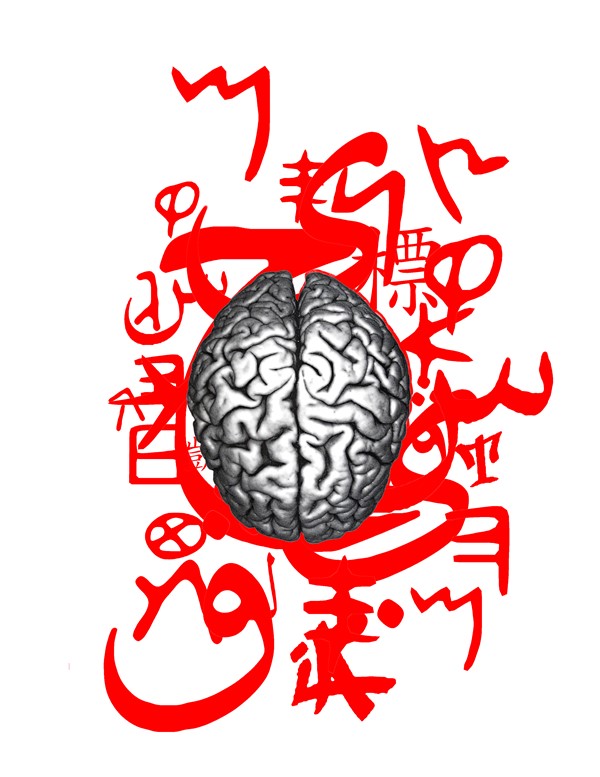Mastering the art of transcreation

Translation is more than a simple swapping of words from one language to the next. Ruth Wyatt explores transcreation and the localisation of brand language
Former British beauty queen, glamour model and celebrity Danielle Lloyd wanted a classy tattoo. Aside from the fact that classy tattoo is an oxymoron of the first order, her head-on collision with Latin is an object lesson in the importance of good translation.
Her shoulder was supposed to read, “To diminish me will only make me stronger.” It actually translates as, “As who am I wearing away for myself, I only set (it) down for/on myself, strong man (that I am).”
Lloyd is far from alone in having nonsense inked into her skin. Another example that did the rounds on social media is the unfortunate woman who wanted to write, “I love [name of boyfriend],” down her spine in Hebrew, but ended up with, “Babylon is the world’s leading dictionary and translation software,” instead.
As famed oilwell firefighter Red Adair is credited with saying, if you think it’s expensive to hire a professional to do the job, wait till you hire an amateur. Yet, allegedly, many leading brands do go for the cheap – or perhaps, more accurately, the unthinking – option when it comes to translation.
Good translation doesn’t just mean faithful or accurate transcription from one language to another. If it did, Coca Cola in China would be known as, “Mare stuffed with wax,” or “Bite the wax tadpole,” which is what the Chinese characters that together make the sound ‘Coca Cola’ mean depending on the dialect (Chinese characters have both a sound and a meaning). Instead it has a different name pronounced “Kokou-Kolay”, which means, “A pleasure in the mouth.” Experts in the field refer to this highly successful strategy as transcreation rather than mere translation, or intelligent localisation.
UK-based localisation agency Conversis CEO and managing director Gary Muddyman says, “Translation is just one element of global brand management. A lot of time is invested coming up with brands and communications pieces for all global brands, in terms of visuals and graphics, but also the words. All that hard work is lost if you then do a poor translation job. People tend to think of translation as very simple conversion; you take a load of words and you put the appropriate words for that language into a sentence and it works out. It isn’t and it doesn’t. It’s much more complicated than that, particularly when
you’re talking about external communications and specifically marketing and brand pieces.
“It’s as much about look and feel as cultural adaptation. Of course, there will also be legal and regulatory differences from country to country. There will be market norms that are different from country to country, distribution differences and so on. All of that would come into localisation. Translation is purely and simply the conversion of the words. Yes, it is important to brands, but only as part of a basket of considerations that you need to make.”

Muddyman was head of corporate development at HSBC and was involved in the world’s local bank brand initiative. “After nearly 500 man hours of work in coming up with the concept, nobody mentioned translation once,” he sighs. “That’s why I’m in the translation industry. I was the person who had to catch the ball, to try to work through that particular challenge and realise I didn’t even know where to start.”
Thankfully times have changed and some companies have developed a more thoughtful and enlightened approached to adapt their messaging to the panoply of international languages. Nick Parker, strategy partner at London-based brand language agency the Writer, believes there is growing recognition of the subliminal benefits of communicating like a native speaker. “Even the effort put in to translating your message appropriately is important – it says to your customers that you’ve gone to the trouble of getting it right, which increases the strength of your relationship, Customers like and trust brands more that make the effort even if they make mistakes along the way,” he says.
Parker adds, “Look at Google. All its terms and conditions are archived so you can see how its language and tone has changed over time. It has got friendlier as time has gone on, the information is simpler and clearer, and it sounds more Google now. That rarely happens naturally. It usually is the result of a lot of work.” And investment.
Google was cited as an example by several experts in the field and all agree that it takes time and a whole lot of money to do it right. Language and transcreation agency thebigword’s chief commercial officer Josh Gould says, “Google is a multi- billion dollar company trading across a number of markets but with the same approachable, conversational tone in all. It does more training than any other company I’ve ever met. It really invests in its people and its suppliers people so that linguists speaking or writing as Google are well trained, aligned and motivated. It works.”
All those who praised Google noted that it is a tough gig with incredibly high standards. “They tell [recruits] it is Harvard. Not the Harvard of the business world, but Harvard period. The majority who enter fail,” notes a well-placed source. “It’s rigorous all right.”
This alludes to the central and somewhat thorny issue of control. Some characterise Google as an uber-controlling organisation that delivers consistency of brand experience through strict discipline. Others believe its investment of time and money in staff empowers them – liberates them – to deliver consistency by living the brand values.
Whichever the case, the spectrum of control is a pertinent consideration. “We organised a summit for the all the brand language heads,” says Parker. “And while people from BT and PWC were talking about detailed guidelines, policies and process, the guy from Innocent was explaining how he spent four months looking for a Norwegian writer whose style and tone fitted with the brand’s ethos.”
Control versus empowerment is never going to be easy to answer, or even possible given the vagaries of business and the nature of the organisation for whom one works. Both strive for consistency in delivery, which is what every brand custodian wants, but any marketer worth his or her salt also wants the brand to be meaningful to its audience, and that requires a much greater degree of flexibility.
McDonald’s has invested billions in installing its strapline, “I’m lovin’ it,” in the global consciousness and for such a brand you’d expect consistency to be king, queen and all the courtiers and for that particular phrase to be used exactly as is around the world. However, that would be a mistake in China as love is a serious word. Traditionally the word is never said aloud. Even today lovers use, “I like you” to communicate great affection without actually saying love, according to global transcreation agency Mother Tongue’s CEO Guy Gilpin’s marvelous volume ‘The Little Book of Transcreation.’ McDonald’s accepted the need to adapt and opted instead for, “I just like (it),” which is more normal, more everyday vocabulary, easier on Chinese ears and retains the youthful, confident street vibe of the English original.
“People tend to think of translation as very simple conversion; you take a load of words and you put the appropriate words for that language into a sentence and it works out. It’s much more complicated than that”

There are many examples where constancy of global messaging or positioning would have been a mistake. A campaign by Intel in Brazil demonstrates the point. The English slogan, “Sponsors of Tomorrow,” translated directly in Portuguese would imply that the brand doesn’t yet deliver on its promises. “In love with tomorrow,” stays true to the values expressed in the rational original English line, but importantly is much more in keeping with a Brazilian population falling more and more in love with the latest high tech products.
When Motorola launched its Q phone in Canada it hadn’t foreseen the hilarity with which its marketing messaging would be received by French speakers. ‘Q’ sounds much like ‘cul’ – that is ass – in French. Lines like, “L’intelligence renouvelee” and “Si c’est important pour vous, c’est important pour votre Q,” in common parlance became, “My ass. Renewed intelligence,” and, “If it’s important to you, it’s important to your ass.” Pepsi’s unwitting claim to rejuvenate the dead went down in the annals of advertising history as how not to pull off a global campaign. “Come alive with Pepsi!” actually means “Pepsi. Bring your ancestors back from the dead” in Chinese.
Haribo is an institution in its home market, Germany, and its strapline, “Haribo macht Kinder froh, und Erwachsene ebenso,” works perfectly there. Literally translated it becomes the stilted, dry and decidedly unmotivating, “Haribo makes kids happy, and adults too.” It doesn’t even rhyme, damn it. How much more appropriate for the brand is the reimagined UK version? “Kids and grown-ups love it so, the happy world of Haribo.”
Translating jingles can be a nightmare, as Gillette found. The German translation of, “The best a man can get,” comes out as, “For the best inside a man,” which doesn’t make a whole lot of sense given that facial hair is on the outside, not the inside of a man. In addition, the line was too short for the music and so had to be dragged out for longer than sounds natural. And it doesn’t even rhyme with Gillette. The tortured and tortuous result: “Fur das Be-e-e-est-e-e im Ma-a-an” became a national laughing stock.
This is where transcreation comes into its own. Transcreation is the process of adapting the messaging to resonate meaningfully with the local target audience while staying true to the meaning of the original and maintaining its intent, style, tone and context. As Gilpin puts it, “Transcreation allows brands to walk the fine line that ensures they are both fresh and relevant locally, and at the same time consistent globally.”
BMW has used the tagline, “Freude am Fahren” (Pleasure in driving) since 1969 in Germany. “Would that be as effective as ‘The Ultimate Driving Machine’? Same idea, different words – that’s what transcreation is all about,” Gilpin says. Maintaining a consistent tone of voice across your communications across different languages and regions is a challenge as Parker points out. “Your brand may have adopted a friendly, approachable tone of voice, so you have to look at what are the indicators of friendliness in the particular language you are translating into. Charming has a very specific feel in English; how do you work out what is charming in Swiss German? And what if it charming in Swiss German turns out to be too idiosyncratic for your brand positioning?” he says. “There are no easy answers – it takes experience, research and creativity.”
Transcreation is about far more than words. Colours mean different things to different people. In the western world yellow is associated with cowardice, whereas in Japan it signifies courage. White is for weddings in the west and funerals in Asia. Red symbolises purity in India and passion in Europe. Lifestyle imagery must be sensitive to the audience’s experience, which is easy to observe and difficult to execute.
And don’t think going down the visual only route is a get out of jail free card. A major pharmaceutical company decided to do the visual only treatment for the international launch of a new product using pictures to explain the benefit. On the left, the ill patient; middle picture of patient taking medicine and the final shot on the right showing him recovered. The problem with that was potential customers in the United Arab Emirates read right to left.
Anomalous though it is, it may be necessary for your brand to look and sound different, and say different things to different people, in order to maintain brand consistency. “There’s a fine line between brand dilution and true localisation,” says Gould. “But without localisation you are potentially harming your business and your brand, from credibility to sales – and you may never know by how much.”


